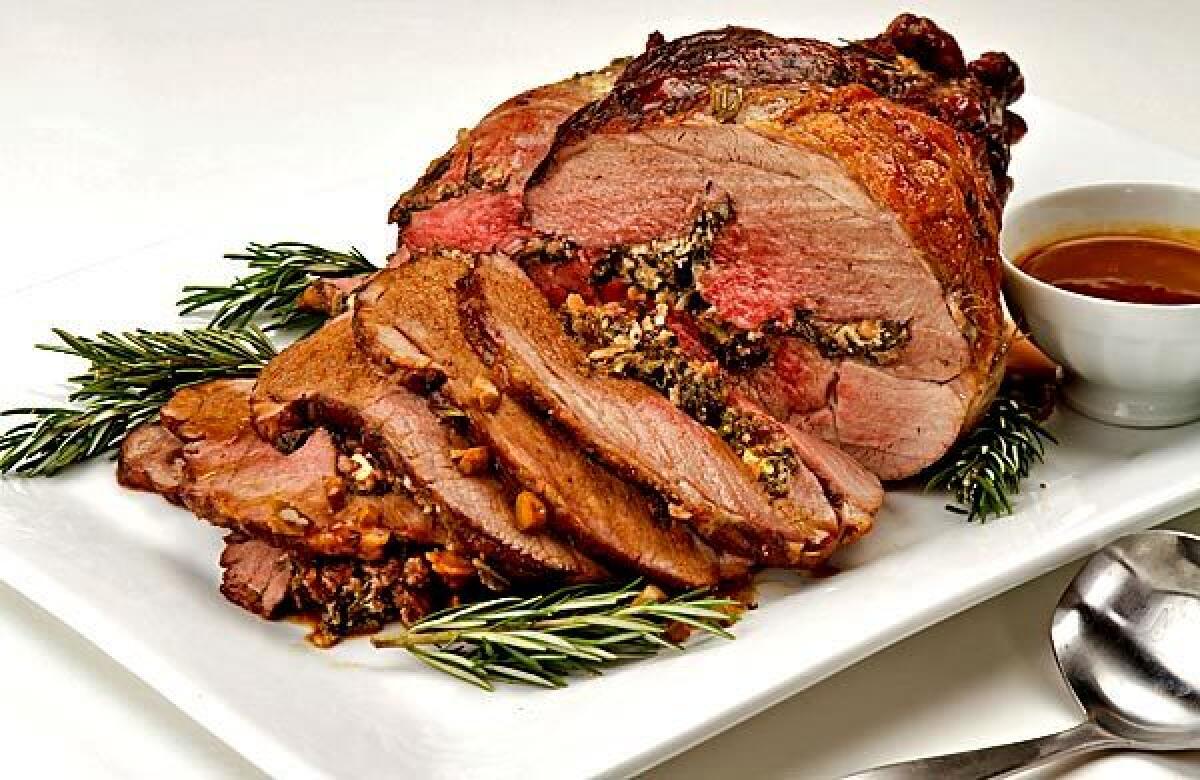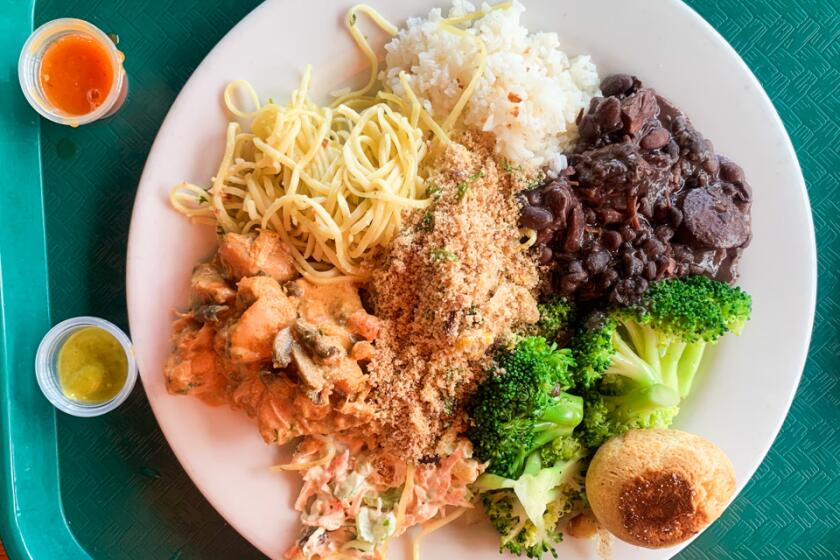The California Cook: Stuffed leg of lamb — it’s worth the effort

I’m a high-payback kind of cook. What I mean by that is that any effort I expend in the kitchen, I expect to have repaid several times over on the plate.
You can put that down to philosophy if you want — that whole California thing of choosing good ingredients and letting them speak for themselves. Or you can attribute it to my modest technical skills — elaborate constructions with lots of elements just aren’t my thing. I did enough fluting of mushrooms in my 20s, thank you.
Or maybe — and more and more I’m thinking this might be it — both of those are just rationalizations for my inherent laziness. Whatever.
But even the most chronic layabout occasionally wants to do something a little special. That usually happens during the holidays, when the dining table becomes a place to gather, rather than just a place to eat. And so for this Easter, I’m proposing a boned leg of lamb, stuffed with greens, feta and pine nuts. It may be a bit complicated to put together, but the payoff is immense.
Not only are the flavors bold — roast lamb, bitter greens, salty feta and a sauce spiked with green olives — but it’s visually impressive as well. Sound like too much for you to do? Just take it one step at a time. And if you need to, you can do most of the work the day before.
The first thing to do is prepare the greens, because you’ll want them to be thoroughly cooled before you add the cheese and stuff the lamb. The Greek term for this kind of vegetable is “horta,” which, informally, is sometimes translated as “weeds.” That’s a bit insulting, even if it does capture the flexibility of the choices and the taste you’re looking for. You want greens with an assertive flavor.
Your photos: Show us the special foods that you prepared for your Seder or Easter menu.
I’ve even begun using bolted lettuces from my garden to get the same effect; the heat and bitterness that comes when the plant shifts its energies from sending out leaves to producing flowers and seeds is just right, especially for punching up a mix that might be milder than you’d like.
Preparing the lamb is the most complicated part of the recipe, but it’s really not that difficult. It used to be that fixing a dish like this required careful knife work to remove the leg, knee and hip bones while leaving the muscles in one piece. Today, most of the lamb legs you’ll find in the market are already boned, so the most technical part of the job is already done.
The first thing to do is slice the leg so it will lay flat, opening out like a book. Sometimes the boned leg will come already like this. Other times the bone will have been removed with the leg muscles more or less intact. (It’s amazing what they’ve taught machines to do these days.) If this is the case, find the spot where the meat is the thinnest and slice through.
When the leg is laying flat, you’ll notice that there will be several spots where the muscle is noticeably thicker than others. You’ll also notice that in those places, the leg isn’t laying completely flat, either. To fix that, use a sharp knife to slice into the middle of that part of the muscle lengthwise (from hip to shank). Not too deep — only an inch or so. Be careful to make a clean cut, preferably in one stroke. Lightly pound the meat with a rolling pin — lightly, you’re just trying to flatten it a little more, not turn it into schnitzel.
To stuff the lamb, arrange the leg on the work surface. It will be roughly triangular in shape. (OK, very roughly.) Have the narrow part facing toward you. Spoon the stuffing over the lamb in a fairly even layer, making sure that some works its way into the slices you’ve created. You’re going to roll it up, so leave a margin around the edges to keep too much of the stuffing from squishing out.
Roll up the leg of lamb, starting with the narrow end and rolling toward the wide end. Wrap a length of unbleached cotton butchers’ twine around the middle of the roll and tie it closed. Don’t roll and tie too tightly as the meat will expand during cooking. It should be just tight enough to hold it in place. Make another wrap from end to end, tucking in that flap of meat that sticks out, then hit it with another couple of cross-wise wraps.
That’s the hardest part done, and it wasn’t so bad, was it? Still, you might prefer to do this much a day in advance; just stick the roast in a plastic bag and refrigerate it overnight. Do be sure to remove it from the fridge and let it come close to room temperature before beginning to roast though.
You’ll want to cook the lamb to about 135 degrees. That’s about medium-rare (the meat fibers are set, but it’s still pink in the center). You can go a little longer if you prefer, but I wouldn’t cook it much less than that. Lamb leg has a lot of sinew and that needs to be cooked for a while to soften.
When the roast is done, tent it with aluminum foil and set it aside to rest for at least a half-hour, and preferably closer to an hour, before you untie and slice it. If you try too early, the roast will want to unroll.
You’ll need a little bit of time to make the sauce anyway. It’s just a simple pan sauce — mainly the roast drippings, a little white wine and some chicken stock, seasoned with rosemary and chopped green olives. Don’t skip straining the sauce, though, and the more you do it, the silkier it will be.
Carve the roast in the kitchen — even with a good rest it may still want to unroll and you’ll want a little privacy to straighten it up and make it pretty. The first slice is always the hardest to keep in shape. Don’t worry if that one turns out messy. Just put it at one end of the platter and cover it with the better slices.
Ladle a little sauce down the center and pour the rest into a gravy boat. What? You were going to pass a saucepan at the table?
Look, this thing might not have been all that hard to make, but you don’t want your guests to know that.
More to Read
Eat your way across L.A.
Get our weekly Tasting Notes newsletter for reviews, news and more.
You may occasionally receive promotional content from the Los Angeles Times.







